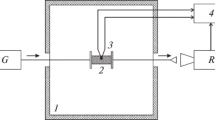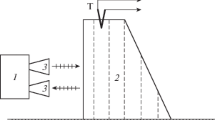Abstract
The decay of microwave radiation in melting fresh ice is studied in the millimeter wavelength range (at frequencies of 90 and 34 GHz). It is demonstrated that ice at a temperature of 0°C may exhibit a decrease in the electromagnetic loss up to several tens of percents presumably due to the streamflow in the presence of internal mechanical stress or complete absence of loss at different stages of melting.
Similar content being viewed by others
References
S. G. Warren, Appl. Opt. 23, 1206 (1984).
C. Matzler and U. Wegmuller, J. Phys. D: Appl. Phys. 20, 1623 (1987).
G. S. Bordonskii, A. O. Orlov, and T. G. Filippova, J. Commun. Technol. Electron. 51, 297 (2006).
J. H. Jiang and D. L. Wu, Atmospheric Sci. Lett. 5(7), 146 (2004).
G. S. Bordonskii, A. A. Gurulev, and S. D. Krylov, Tech. Phys. Lett. 35, 1047 (2009).
V. F. Petrenko and R. W. Whitworth, Physics of Ice (Clarendon, Oxford, 1999).
L. I. Men’shikov, Usp. Fiz. Nauk 169, 113 (1999).
V. G. Glushnev, B. D. Slutsker, and M. I. Finkel’shtein, Izv. Vyssh. Uchebn. Zaved., Radiofiz. 19, 1305 (1976).
A. Stogryn, IEEE Trans. Geosci. Electron. 24, 220 (1986).
V. V. Bogorodskii and V. P. Gavrilo, Ice. Physical Characteristics. Modern Methods in Glaciology (Gidrometeoizdat, Leningrad, 1980) [in Russian].
G. S. Bordonskii, Phys. Solid State 47, 715 (2005).
R. A. Silin, Periodic Waveguides (Fazis, Moscow, 2002) [in Russian].
V. M. Agranovich and V. L. Ginzburg, Crystal Optics with Spatial Dispersion and Excitons (Nauka, Moscow, 1979; Springer-Verlag, New York, 1984).
S. I. Pekar, Crystal Optics and Additional Light Waves (Naukova Dumka, Kiev, 1982) [in Russian].
G. S. Bordonskiy, A. A. Gurulev, S. D. Krylov, A. Ts. Tsybikzhapov, and S. V. Tsyrenzhapov, Tech. Phys. 76, 626 (2006).
G. S. Bordonskii, A. O. Orlov, and T. G. Filippova, Izv. Vyssh. Uchebn. Zaved., Radiofiz. 47, 292 (2004).
V. P. Starr, Physics of Negative Viscosity Phenomena (McGraw-Hill, New York, 1968; Mir, Moscow, 1971).
I. A. Bashkirtseva, A. Yu. Zubarev, L. Yu. Iskakova, and L. B. Ryashko, Nelin. Din. 5, 603 (2009).
R. Drews, O. Eisen, I. Weikusat, et al., Cryosphere 3, 195 (2009).
Author information
Authors and Affiliations
Corresponding author
Additional information
Original Russian Text © G.S. Bordonskii, A.A. Gurulev, S.D. Krylov, 2014, published in Radiotekhnika i Elektronika, 2014, Vol. 59, No. 6, pp. 587–592.
Rights and permissions
About this article
Cite this article
Bordonskii, G.S., Gurulev, A.A. & Krylov, S.D. Electromagnetic loss of fresh ice in microwave range at a temperature of 0°C. J. Commun. Technol. Electron. 59, 536–540 (2014). https://doi.org/10.1134/S1064226914060060
Received:
Published:
Issue Date:
DOI: https://doi.org/10.1134/S1064226914060060




